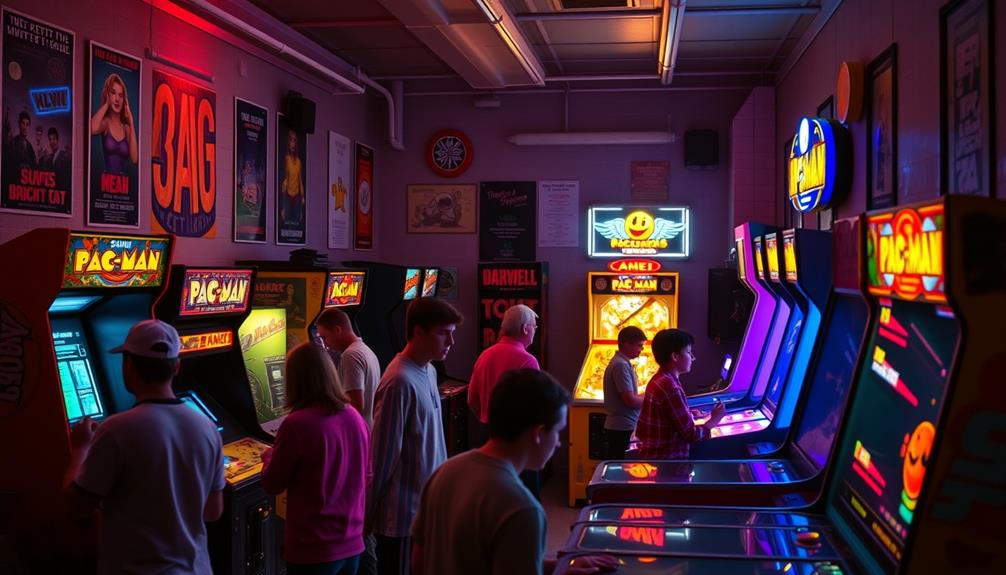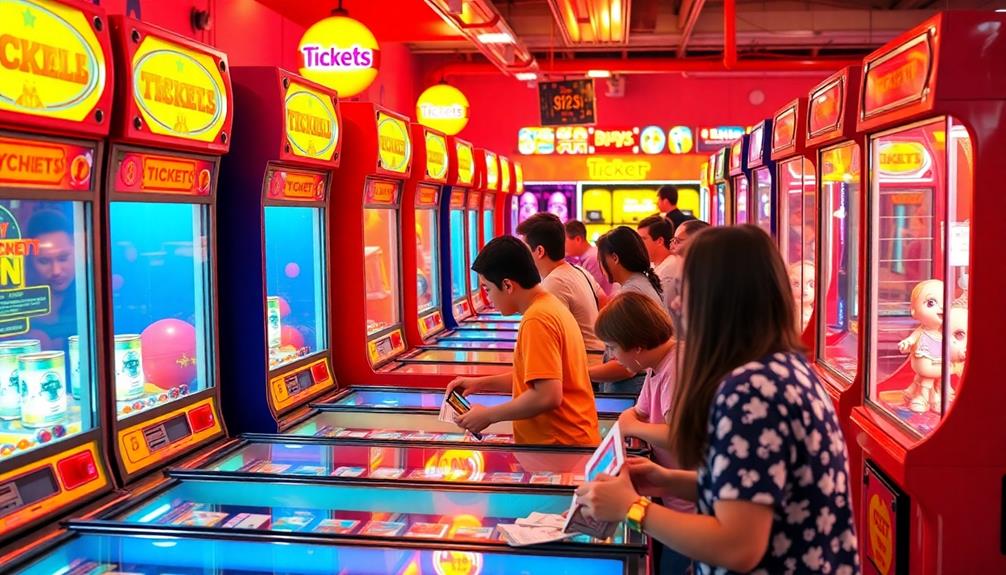In the early 1970s, arcade games gained popularity with the release of Atari’s Pong in 1972. This classic game generated huge interest in arcade gaming, resulting in a surge of video arcades. The late 1970s and early 1980s, known as the Golden Age of Arcades, saw iconic titles like Space Invaders and Pac-Man become integral parts of pop culture. By 1982, arcade revenue skyrocketed to over $8.9 billion, attracting players from all walks of life. If you’re curious about the evolution of this vibrant gaming scene, there is much more to discover. In the mid-1980s, Sega arcade games like Out Run and After Burner took the gaming world by storm, offering new and exciting experiences for players. These games continued to push the boundaries of arcade gaming, contributing to the industry’s lasting popularity with fans. Even today, the influence of these classic arcade games can still be seen in modern gaming culture, demonstrating their timeless impact. For those wondering what arcade games are, they are typically coin-operated machines featuring a variety of video games, from classic shooters to racing games and more. The appeal of arcade games lies in the immersive and social gaming experience they offer, captivating players with the challenge and thrill of each game. With a rich history and enduring popularity, arcade games continue to have a special place in the hearts of gamers worldwide.
Key Takeaways
- Arcade games gained popularity in the early 1970s with the release of Computer Space in 1971 and Atari's Pong in 1972.
- The late 1970s to early 1980s marked the Golden Age of arcades, featuring iconic titles like Space Invaders and Pac-Man.
- By 1982, the arcade industry generated over $8.9 billion in revenue, indicating widespread popularity and engagement.
- Cultural phenomena like Pac-Man and Donkey Kong fostered community and competitive gaming, solidifying arcade popularity.
- The decline in arcade popularity began in the early 1990s with the rise of home consoles, shifting player preferences.
Origins of Arcade Gaming
In the early 1970s, arcade gaming burst onto the scene with the release of the first commercial game, Computer Space, by Nutting Associates in 1971. This marked the beginning of an exciting new form of entertainment.
You'd soon see the rise of arcade games that transformed social spaces into gaming hubs, similar to the evolution observed in best rated pinball machines that captivated audiences with their advanced technology.
Just a year later, in 1972, Atari released Pong, a simplistic yet addictive ping-pong simulation. It quickly became a massive hit and played a vital role in popularizing arcade gaming, paving the way for more complex games.
The Golden Age of Arcade gaming kicked off in 1978 with the launch of Space Invaders, which sold over 100,000 machines in Japan that year alone.
By 1982, the U.S. boasted over 13,000 arcades, with popular machines raking in profits exceeding $400 daily.
As the decade progressed, Pac-Man entered the scene in 1980, becoming the best-selling video game of its time. It sold around 400,000 arcade cabinets by 1982, further solidifying the phenomenon of arcade gaming and its cultural significance in entertainment history.
The Rise of Coin-Operated Games
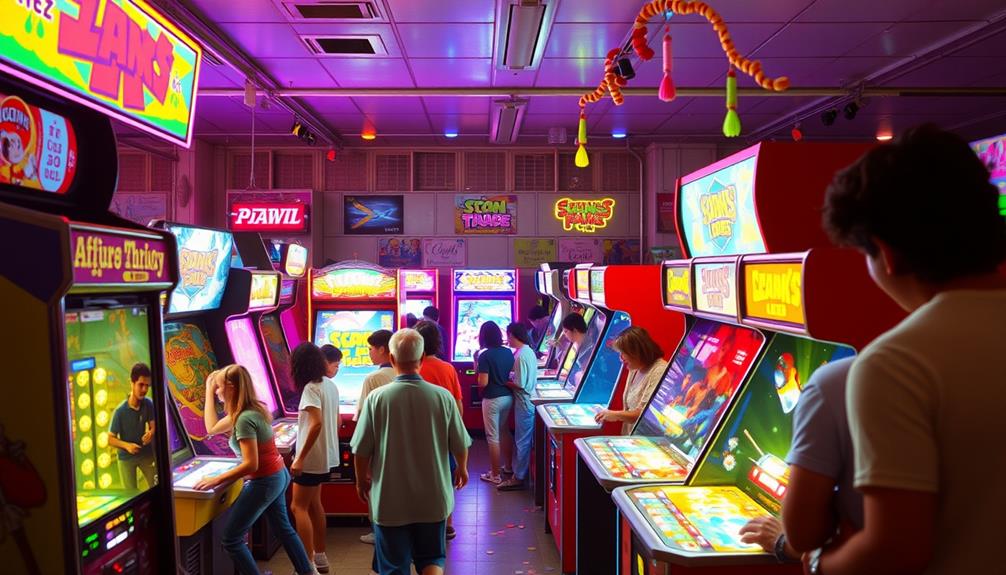
You might be surprised to learn that coin-operated machines first captured attention in the early 20th century, setting the stage for a gaming revolution.
The popularization of pinball machines in the 1940s and 1950s contributed greatly to the allure of coin-operated games, as they became a staple in arcades and bars.
With the arrival of video games like Computer Space and Pong, arcade gaming quickly transformed into a cultural sensation.
The impact of pinball machines also laid the groundwork, making coin-operated entertainment a staple in amusement halls across the country.
Early Coin-Operated Machines
The rise of coin-operated machines transformed entertainment in the early 20th century, engaging audiences in amusement halls across the country. You might've experienced the thrill of early coin-operated games, which began gaining popularity during this era.
Pinball machines became a standout attraction in the 1930s, drawing players despite facing bans in several venues from the 1940s to the 1960s. This era of innovation was reminiscent of the heartwarming themes found in songs like Blue Skies and Lemonade, which evoke feelings of joy and nostalgia.
The 1960s saw a wave of innovation with the emergence of electro-mechanical (EM) games like Sega's Periscope, capturing the imagination of enthusiastic gamers.
This technological advancement paved the way for the first commercial arcade video game, Computer Space, created by Nolan Bushnell and Ted Dabney in 1971. Although it was a groundbreaking moment, it was the release of Pong in 1972 that truly revolutionized the arcade scene.
Pong's immense commercial success led to the widespread adoption of arcade cabinets, making coin-operated games a staple in entertainment venues.
This period marked a significant turning point, as amusement halls filled with enthusiastic gamers, all seeking the excitement these machines offered.
Emergence of Video Games
As coin-operated machines paved the way for innovative entertainment, the arrival of video games in the early 1970s marked a significant shift in the gaming landscape. The emergence of arcade games began with the release of Computer Space in 1971, but it was Atari's Pong in 1972 that truly ignited the arcade craze.
You could see the impact of Pong's commercial success as it generated over $40 daily per machine, drawing in gamers from all walks of life. This boom in gaming popularity coincided with a cultural fascination with celebrity lifestyles, as seen in how celebrities design their retreats to reflect their passions and interests.
The golden age of arcade games, spanning the late 1970s to the early 1980s, saw iconic titles capture the public's imagination.
Here are three key milestones that defined this era:
- Space Invaders (1978) – Sold over 100,000 machines in Japan within the same year, setting a new standard.
- Pac-Man (1980) – Became the best-selling arcade game, with around 400,000 cabinets sold by 1982.
- Explosion of Arcades – By January 1982, over 13,000 arcades reported in the U.S., showcasing the rapid growth of coin-operated gaming.
These titles not only transformed the industry but also laid the foundation for future gaming innovations.
Impact of Pinball Machines
With their vibrant lights and enchanting sounds, pinball machines carved out a unique niche in the entertainment landscape long before video arcade games took center stage. Emerging in the early 20th century, these machines became the main attractions in amusement halls.
The evolution of pinball machines included various enhancements, such as optimal angles for gameplay, which improved player performance and enjoyment. However, during the 1940s to 1960s, many pinball machines faced bans due to strict gambling laws, threatening their popularity.
The introduction of electro-mechanical games in the 1960s, such as Sega's Periscope, sparked technological advancements, paving the way for future arcade cabinets. This evolution didn't just influence the machines themselves; it shaped the industry.
Nolan Bushnell, inspired by pinball machines, gained valuable insights into the game business, which led him to create the first arcade video game, Computer Space, in 1971.
The success of Pong in 1972, following pinball's rise, marked a significant turning point for coin-operated games. It shifted the focus from mechanical gameplay to digital gameplay, forever changing the gaming landscape.
Pinball machines laid the groundwork for this transformation, showcasing the potential of coin-operated games and setting the stage for the arcade dominance that's evident today.
The Golden Age of Arcades
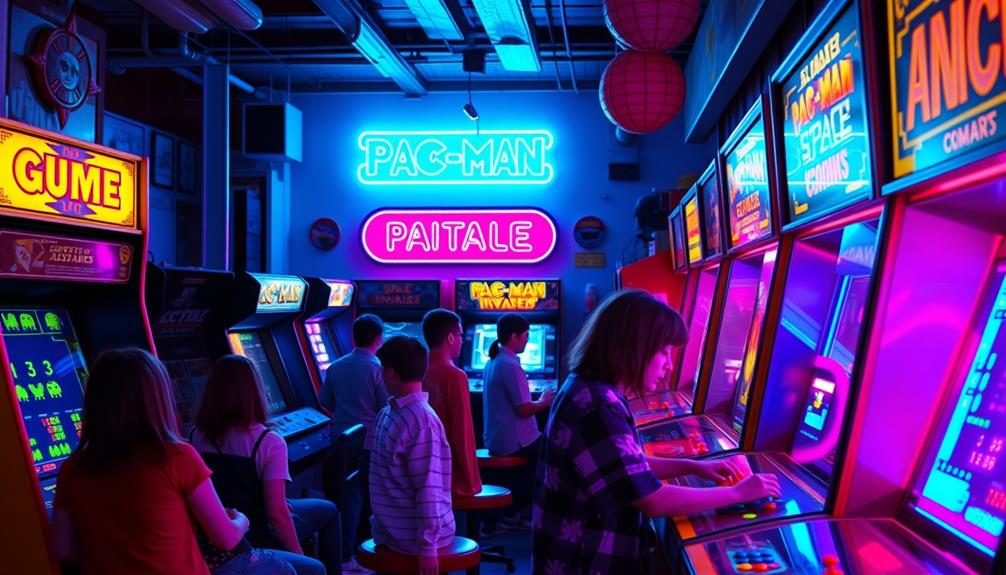
The Golden Age of Arcades was truly a transformative time for gaming, with iconic titles like Pac-Man and Donkey Kong capturing your attention and sparking a cultural phenomenon.
As you explored the growing number of arcades, you'd notice how these games not only entertained but also drove a booming market, with profits soaring daily.
The appeal of these games was often enhanced by their astrological associations, as studies suggest a correlation between star appeal in gaming and perceived attractiveness.
This era laid the groundwork for major gaming companies that shaped the industry, making it an unforgettable chapter in arcade history.
Key Titles of Era
During the Golden Age of Arcades, which spanned from the late 1970s to the early 1980s, several key titles emerged that not only defined the era but also shaped the future of gaming.
These iconic titles drove arcade popularity and created a competitive landscape that still resonates today. In this period, the balance between creativity and gameplay mechanics became essential, as emphasized in design thinking frameworks that focus on user-centric solutions.
Here are three standout games that made a significant impact:
- Space Invaders (1978) – This game was pivotal in establishing the arcade gaming trend, selling over 100,000 machines in Japan by the end of its release year. Its simple yet addictive gameplay drew players in droves.
- Pac-Man (1980) – With approximately 400,000 arcade cabinets sold by 1982, Pac-Man became a cultural phenomenon. Its unique maze-chase format captivated a diverse audience, making it a staple in arcades.
- Donkey Kong (1981) – This title introduced narrative-driven gameplay and debuted Mario, Nintendo's iconic character. Donkey Kong further fueled arcade popularity with its engaging story and challenging levels.
As these titles gained traction, video game tournaments emerged, with Twin Galaxies becoming known for tracking high scores, solidifying the competitive spirit of the era.
Cultural Phenomenon Emergence
Arcade games exploded into a cultural phenomenon in the late 1970s and early 1980s, capturing the imaginations of millions and transforming entertainment landscapes.
The vibrant sounds and engaging visuals of these games not only provided an escape but also fostered a sense of community among players, reminiscent of how music therapy enhances emotional well-being.
This period, known as the Golden Age of Arcades, saw the release of groundbreaking titles like Space Invaders in 1978, which quickly sold over 100,000 machines in Japan.
You probably remember how Pac-Man, released in 1980, became the best-selling video game of its time, generating around $400 million and leading to the sale of about 400,000 arcade cabinets by 1982.
Market Expansion Factors
As arcade games captured the hearts of players, several factors fueled their market expansion during the Golden Age. The release of iconic titles like Pac-Man and Space Invaders transformed arcades into cultural hubs, attracting massive crowds and generating significant revenue.
By 1982, the arcade industry boasted over $8.9 billion in revenue and more than 13,000 arcades across the U.S., reflecting a booming market. This expansion can also be seen as a precursor to the modern gaming industry, where understanding financial health through a personal budget has become essential for many gamers.
Here are three key factors that contributed to this expansion:
- Innovative Game Design: Games introduced features like persistent high scores and interactive audio, enhancing the gameplay experience and fostering a competitive atmosphere.
- Social Engagement: Arcades became gathering spots for friends and strangers alike, turning gaming into a communal activity that drew in diverse audiences.
- Iconic Titles: The massive popularity of games like Pac-Man, with around 400,000 cabinets sold, solidified the arcade's status as a dominant entertainment medium.
These elements combined not only drove the success of the arcade games but also laid the groundwork for a vibrant arcade industry that thrived during this Golden Age.
Cultural Impact of Arcade Games
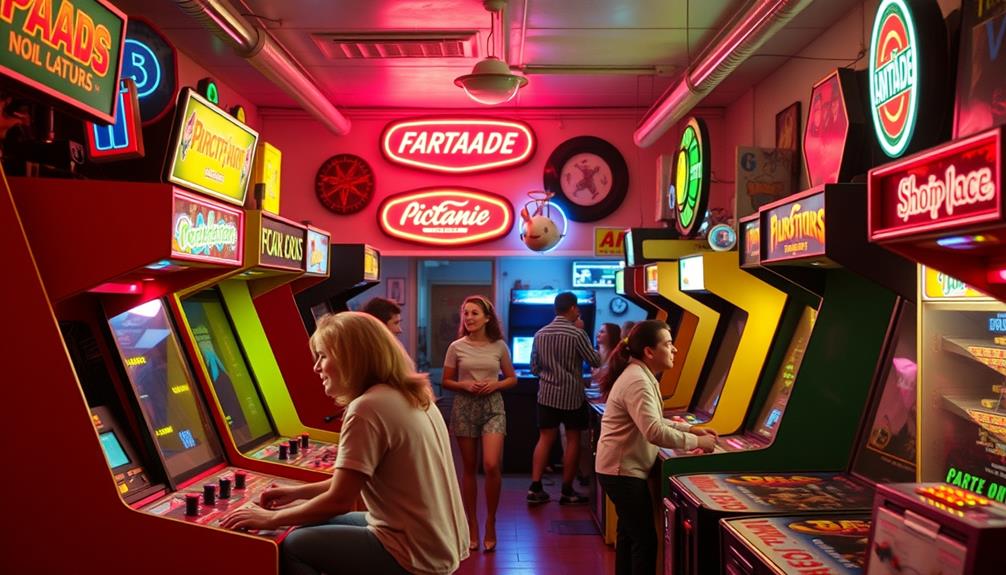
While many people associate the 1980s with vibrant fashion and music, arcade games emerged as a cultural phenomenon that captured the hearts and minds of a generation. Iconic titles like Pac-Man and Donkey Kong not only entertained but also shaped gaming culture.
The era's social gatherings often mirrored the charm of events like Paula Deen's Wedding Highlights, where community and connection were key. By 1982, the U.S. boasted over 13,000 arcades, with popular machines raking in over $400 daily, marking a significant shift in entertainment venues.
Pac-Man, released in 1980, became the best-selling video game of its time, with approximately 400,000 arcade cabinets sold by 1982. This success sparked the rise of video game tournaments, as organizations like Twin Galaxies began tracking high scores, laying the groundwork for modern esports.
Today, you can still feel the impact of these arcade games through the nostalgia they evoke. Retro gaming venues and arcade bars have surged in popularity, serving as social hubs where you can relive those classic experiences.
The cultural significance of arcade games from the 1980s continues to resonate, reminding you of a time when gaming brought people together in lively entertainment venues.
Iconic Titles and Their Influence
When you think of iconic arcade titles, names like Pac-Man, Space Invaders, and Donkey Kong often come to mind, each leaving a lasting mark on gaming history. These games didn't just entertain; they shaped the arcade landscape.
Here's how they influenced the industry:
- Space Invaders: Launched in 1978, it sold over 100,000 machines in its first year, igniting the arcade boom.
- Pac-Man: Released in 1980, it became a cultural phenomenon, selling about 400,000 arcade cabinets and generating over $3.5 billion in revenue.
- Donkey Kong: Debuting in 1981, it established the platformer genre, pushing competition among arcade manufacturers.
As these titles gained popularity, they paved the way for future innovations. The emergence of fighting games, especially with Street Fighter II in 1991, revitalized arcade gaming by fostering competitive gameplay and social interactions.
These iconic arcade games not only captivated players but also influenced game design and culture, ensuring their legacy endures. The impact of these titles can still be felt today, reminding you of the power of arcade games in shaping the entertainment landscape.
Decline of Arcade Popularity

During the early 1990s, the allure of arcade games began to fade as home consoles like the Nintendo Entertainment System (NES) and Sega Genesis gained popularity.
These systems offered a convenient gaming experience right in your living room, making it easier to enjoy your favorite games without the hassle of heading to an arcade.
By 1983, the U.S. arcade industry faced a drastic decline, with revenue dropping from $8.9 billion in 1982 to $4.5 billion.
The arcade market became saturated with numerous titles, leading to fierce competition that forced many arcades to close by the mid-1980s.
As gaming culture shifted, younger audiences started to gravitate towards home entertainment, greatly reducing foot traffic in arcades.
By the mid-1990s, the introduction of advanced home gaming systems and longer narratives in video games only exacerbated this decline.
With the rise of home consoles and changing preferences, the popularity of arcade games dwindled.
The vibrant atmosphere of arcades began to fade, leaving many to reminisce about the golden age of gaming that seemed to slip away into the past.
Resurgence of Arcade Culture
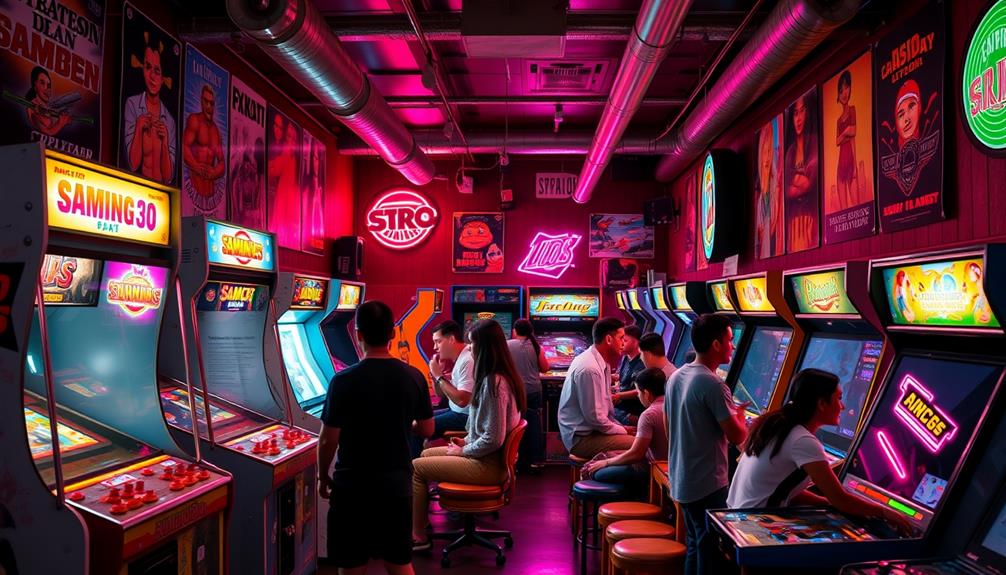
Amid a wave of nostalgia, arcade culture has experienced a remarkable resurgence since the mid-2000s. You can see this revival in several exciting ways:
- Arcade Bars: These venues blend classic arcade games with a vibrant social atmosphere, making them the perfect hangout for friends who want to relive retro gaming nostalgia while enjoying a drink.
- Family Entertainment Centers: These centers have integrated arcade games into their offerings, creating a fun environment for families. They combine dining and entertainment, drawing in younger audiences enthusiastic for social experiences.
- eSports and Competitive Gaming: The rise of eSports has reinvigorated interest in arcade-style play. Competitive gaming events echo the social interactions that defined original arcade culture, making it accessible to a new generation.
Mobile versions of classic arcade games, like Pac-Man, also hit the mark with over 30 million downloads by 2010, proving that the love for arcade games remains strong.
This blend of nostalgia and modern twists guarantees that the arcade culture isn't just surviving but thriving, offering everyone a chance to connect through shared experiences.
Modern Arcade Innovations
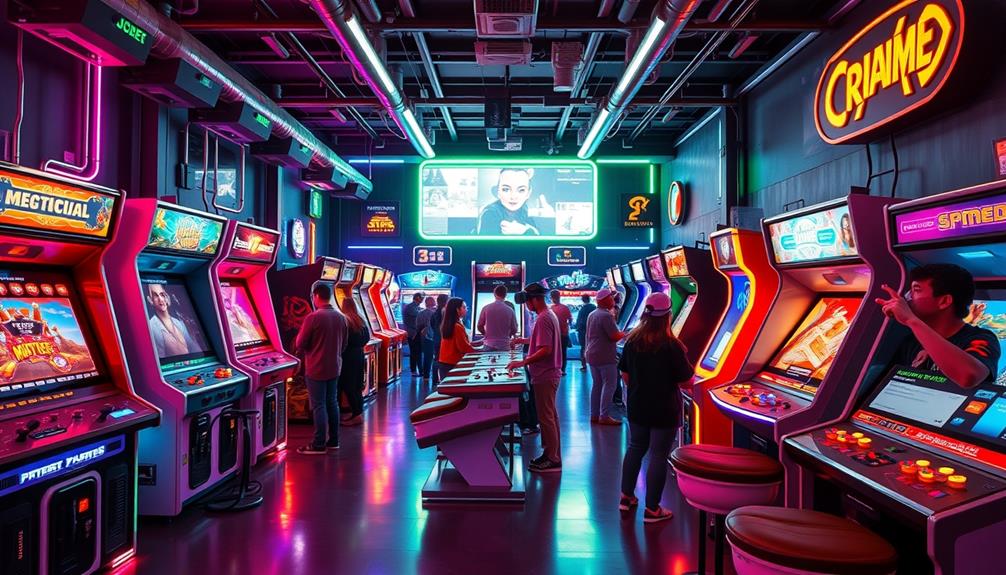
Modern arcade innovations frequently blend cutting-edge technology with the beloved elements of classic gaming, creating an engaging experience for both new and veteran players.
You'll find games featuring real-time 3D graphics and immersive gameplay experiences that captivate your attention and keep you coming back for more.
The rise of arcade bars has transformed gaming into a social activity, where you can enjoy a drink while playing alongside friends.
These venues often host competitive gaming events, fostering a sense of community as players showcase their skills in both modern titles and classic arcade games.
Newer arcade games frequently incorporate redemption mechanics, making them appealing to casual players and families.
Games like claw machines draw in crowds, offering the chance to win prizes while enjoying the thrill of competition.
Additionally, the integration of mobile gaming has allowed classic arcade games to reach new audiences.
Titles like Pac-Man have achieved millions of downloads, proving that nostalgia still holds strong.
In this vibrant landscape, modern arcade innovations continue to evolve, ensuring that the spirit of gaming remains alive and well.
Future Trends in Arcade Gaming
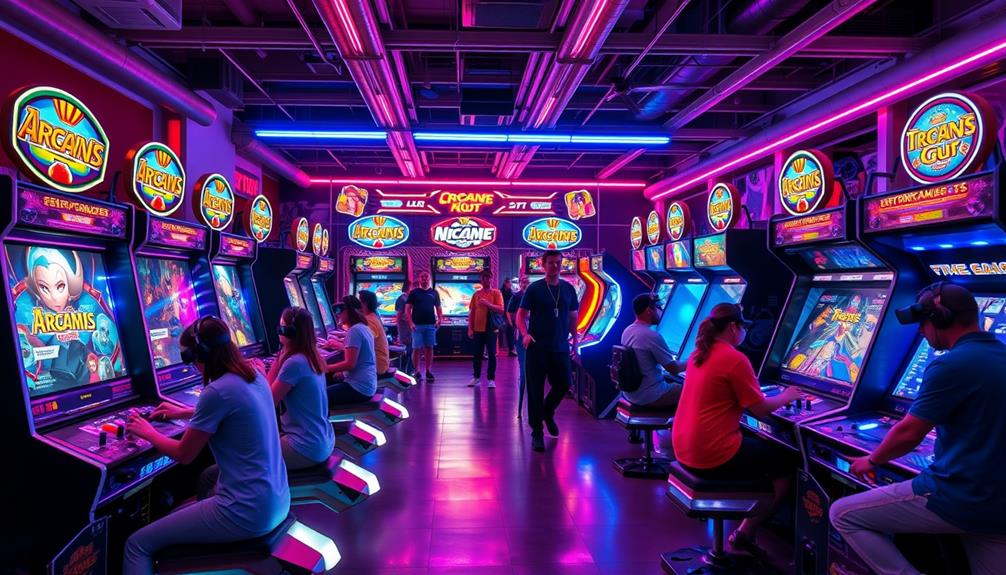
As the arcade gaming sector continues to evolve, exciting trends are reshaping the landscape.
You'll notice a blend of nostalgia and innovation driving the future of arcades, particularly among younger generations. Here are three key trends to watch:
- Rise of Arcade Bars: These venues are merging gaming and socialization, making them hot spots for millennials and Gen Z. You can enjoy classic drinks while challenging friends to retro games or new interactive experiences.
- Technological Advancements: The integration of virtual reality and augmented reality is set to redefine what an arcade can be. Imagine stepping into immersive worlds that blur the lines between gaming and reality!
- Popularity of Redemption Games: These games, focused on skill and rewards, are gaining traction. They're appealing to players seeking instant gratification, and they're changing how you engage with arcade gaming.
As these trends unfold, you'll see arcades evolve into dynamic spaces where interactive experiences take center stage, ensuring that the spirit of gaming remains alive and well.
Embrace the future of arcades and enjoy every moment!
Frequently Asked Questions
When Did Arcade Games Become a Thing?
Arcade games became a thing in the early 1970s, starting with "Computer Space" and gaining momentum with "Pong." As you explore, you'll find their popularity soared during the golden age from 1978 to 1983. During this time, companies like Atari and Namco dominated the arcade game market with hits like “Space Invaders” and “Pac-Man.” However, it wasn’t until the launch of the sega arcade game production in the late 1980s that we saw a shift in the industry. Sega’s introduction of games like “Out Run” and “After Burner” revolutionized the arcade experience and set the stage for the modern era of arcade gaming.
When Did Arcades Peak in Popularity?
Arcades peaked like a vibrant firework in the early 1980s, with iconic games enchanting players. You'd find yourself in a bustling hub, where daily profits soared, and Pac-Man ruled the gaming scene.
Were Arcades Popular in the 2000S?
Arcades struggled in the 2000s as home consoles and online gaming gained traction. You'd find many traditional arcades closing, but some adapted, turning into Family Entertainment Centers or barcades to attract a new audience.
Did People Go to Arcades in the 80S?
In the 80s, arcades buzzed like bees in a hive, drawing crowds enthusiastic to play. You'd find friends laughing, competing, and sharing high scores, making arcades a vibrant social hub for everyone involved.
Conclusion
Arcade games exploded onto the scene like a supernova, enchanting hearts and minds in a dazzling display of lights and sounds! From the adrenaline rush of classic titles to the resurgence of immersive experiences today, you've witnessed a thrilling rollercoaster ride of nostalgia and innovation. As arcades evolve, they're not just surviving; they're becoming the ultimate playgrounds of the future! So get ready, because the next level of arcade gaming is about to blow your socks off!
